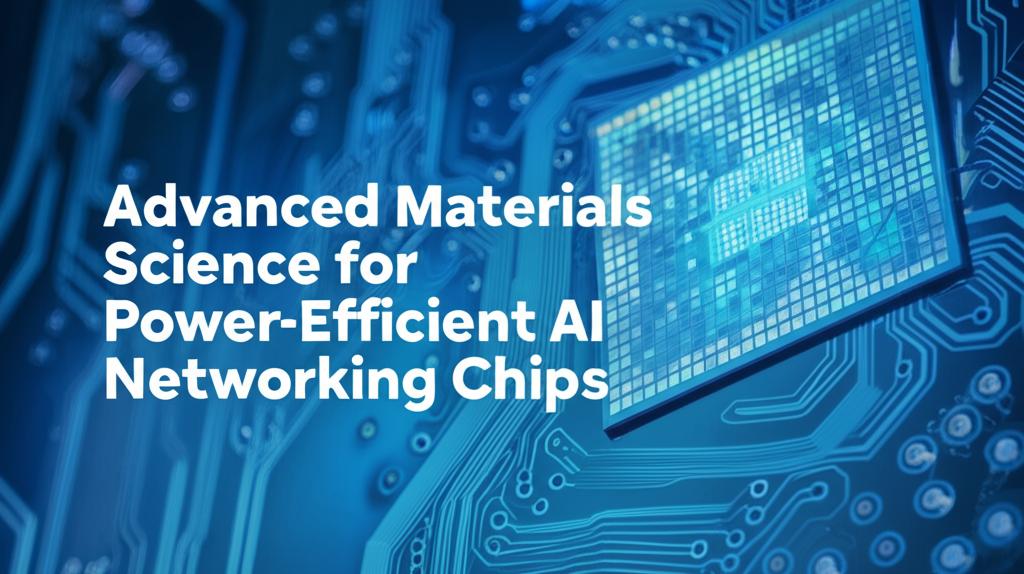The quest for more power-efficient Artificial Intelligence (AI) networking chips is driving significant innovation in materials science. As AI technologies become increasingly sophisticated, their energy consumption grows, posing a substantial challenge. Researchers are exploring novel materials and device architectures to create AI hardware that can perform complex calculations with significantly lower energy demands.
Spintronics: A Brain-Inspired ApproachOne promising avenue is spintronics, which utilizes the spin of electrons in addition to their charge to store and process information. Spintronic devices aim to mimic the human brain's efficiency by integrating memory and computing capabilities. Recent breakthroughs include the development of spintronic devices that allow for electrical mutual control of non-collinear antiferromagnets and ferromagnets. This enables efficient switching of magnetic states, leading to less energy consumption during information storage and processing. This technology holds the potential to revolutionize AI hardware by creating a building block for lower-power, brain-like AI chips. Researchers are focused on further reducing operating currents and increasing readout signals for practical applications in AI chips.
Two-Dimensional (2D) Materials: Thin and MightyTwo-dimensional materials, which are atomically thin layers, are also at the forefront of this research. Materials like graphene, transition metal dichalcogenides (TMDs), and phosphorene exhibit unique electronic and spintronic properties, such as high electron mobility and layer-dependent band gaps. These characteristics make them ideal for creating ultra-small, high-performance, and energy-efficient components for AI chips.
- Enhanced Performance: Researchers anticipate that chips based on 2D materials like TMDs could use significantly less power (potentially around 40% less) and perform up to 1000 times faster than current silicon-based chips.
- Monolithic 3D Integration: A novel approach involves the monolithic 3D integration of layered 2D materials into new processing hardware for AI computing. This method stacks multiple atomically thin 2D layers, each with a distinct function, into a single chip. This dense interlayer connectivity reduces processing time, power consumption, latency, and the overall footprint of the chip, offering unprecedented efficiency for AI tasks.
- Addressing Energy Demands: The development of 2D semiconductors is seen as a key strategy for building a more sustainable AI industry, with the potential to save over 90% of the energy currently required by data centers and computers. This could also dramatically reduce the energy costs of consumer devices like smartphones.
Neuromorphic computing, which aims to replicate the structure and function of the human brain, is another key area. This approach is inherently more energy-efficient for data-intensive tasks like pattern recognition.
- Novel Materials for Neuromorphic Devices: Researchers are exploring various materials for neuromorphic devices, including 2D materials, organic semiconductors, ferroelectrics, iontronics, and spintronics. These materials offer advantages in scalability, energy efficiency, and the ability to create novel device functionalities that mimic neurons and synapses.
- Quantum Materials: Quantum materials, including those exhibiting metal-insulator transitions (like vanadium dioxide, VO2) and spin-torque oscillators, are being investigated for their potential in neuromorphic computing. These materials offer unique ways to manipulate electrical and magnetic states, which can be harnessed to emulate neuronal activities and create analog memory, leading to more compact and energy-efficient AI hardware. Phase change materials (PCM) are also being explored for their use in optical memory architectures for energy-efficient edge computing.
- Halide Perovskite Materials: Research into halide perovskite materials, known for their high ion mobility, has led to the development of neuromorphic devices where ions can be uniformly distributed across the semiconductor surface. This enables more linear and symmetric synaptic weight adjustments, significantly improving AI computation accuracy and energy efficiency.
Beyond the chip materials themselves, advanced packaging technologies play a crucial role in enhancing the power efficiency and performance of AI networking chips.
- Heterogeneous Integration: This allows for the combination of different types of chiplets (e.g., processors, memory, AI accelerators) within a single package. This modular approach improves scalability and can optimize power consumption by using the most efficient process node for each function.
- Improved Thermal and Electrical Performance: Techniques like Fan-Out Wafer-Level Packaging (FOWLP) extend the package beyond the die's boundaries, increasing I/O density and improving electrical and thermal properties. Shorter interconnect paths reduce energy dissipation and signal latency.
- Innovations in Packaging Materials: The use of advanced materials such as high-performance thermal interface materials, low-k dielectrics, conductive adhesives, and glass substrates helps manage heat, reduce power loss, and support higher data rates. Efficient thermal management is critical as chip power density increases.
The development of advanced materials is critical to overcoming the energy consumption challenges associated with the rapid growth of AI. By exploring spintronics, 2D materials, neuromorphic computing principles, and innovative packaging solutions, researchers are paving the way for a new generation of power-efficient AI networking chips. These advancements are essential for the sustainable development and deployment of AI technologies across various applications, from data centers to wearable electronics and edge computing devices. The convergence of materials science, AI-driven design, and heterogeneous integration promises a new era of semiconductor technology.

